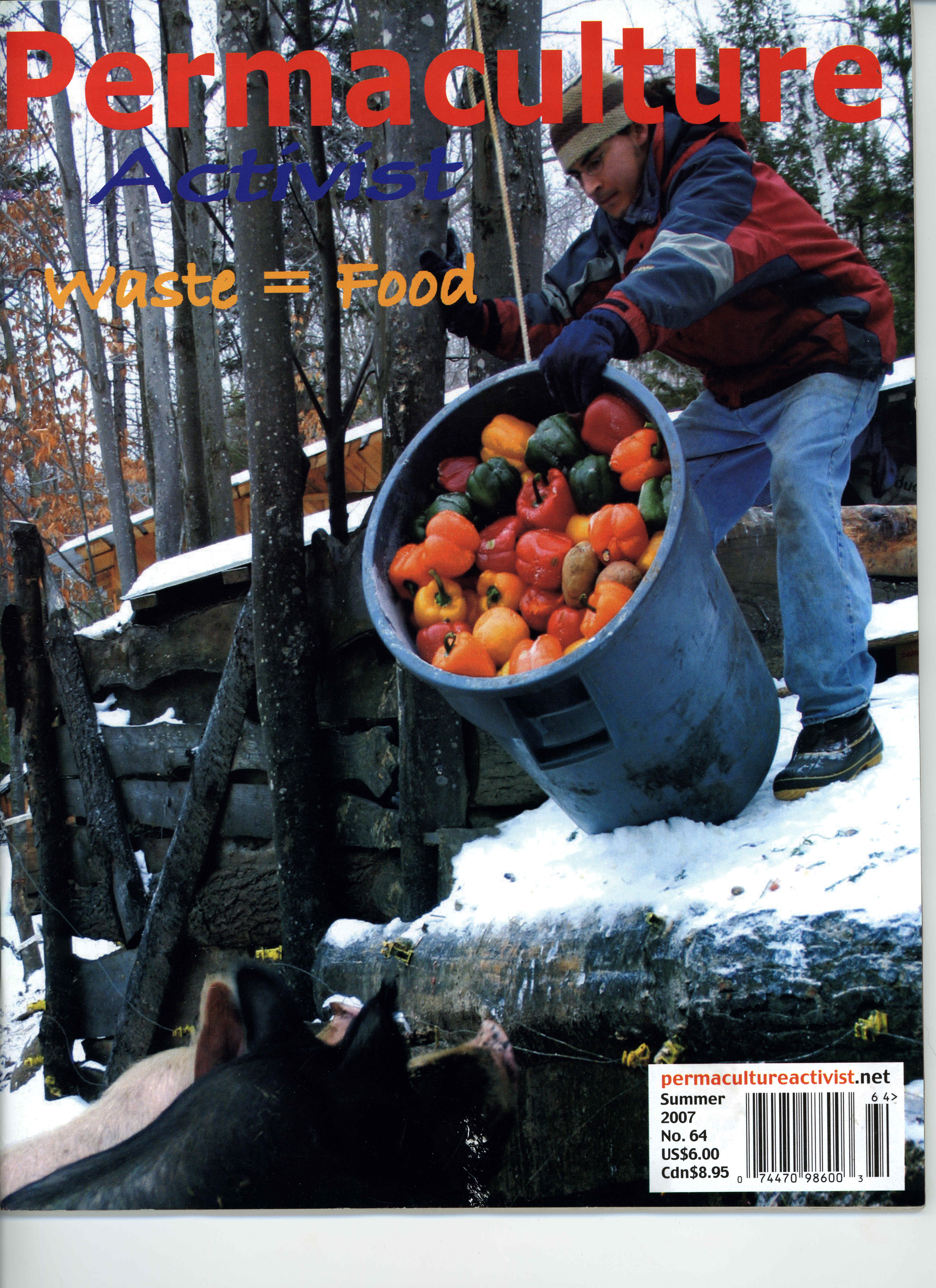· Media > Published Articles > The Movement > Food From Waste: Getting Piggy With Integrated Waste Management |
"Food From Waste: Getting Piggy With Integrated Waste Management" By Josh Trought, as published in Permaculture Activist No. 64 Summer 2007
 At D Acres of NH, we are interested in sustainable living, which, by necessity, involves food production. We are located in a rural setting so we regularly take trips to town for errands and to trade goods and services. Twice a week we drive to town to sell eggs, baked goods, and pick up the mail. Therein lies the rub; we were delivering quite a bit of volume but returning with an empty vehicle.
At D Acres of NH, we are interested in sustainable living, which, by necessity, involves food production. We are located in a rural setting so we regularly take trips to town for errands and to trade goods and services. Twice a week we drive to town to sell eggs, baked goods, and pick up the mail. Therein lies the rub; we were delivering quite a bit of volume but returning with an empty vehicle.
We converted our delivery route into a significant pick-up route. By negotiating with local restaurants, groceries and institutions we have been able to dispose of their waste while producing food and revenue. Our partners in this process are the pigs.
Pigs are a wonderful element of our farm system. They are the land clearers who fertilize while eliminating unwanted vegetation. Their joyful rooting can be directed to tasks that would otherwise be delegated to machinery burning ancient sunlight. We routinely eliminate the toughest weeds like quack grass and bittersweet with the oinkers. Pigs can be effectively contained with electric fence. Piglets sell for over $60 each and a sow can give birth to litters of over ten twice a year.
Before we began our pig food pick-ups we were paying over $15 for a 50# bag of organic feed. The first pigs we raised on organic grains cost about $500 to yield 400 lbs of meat. Between the costs to purchase the pig, the grain, transporting to the slaughterhouse and the packaging there was no margin to retain earnings after sale. So we changed two things, we started to slaughter onsite and we stopped buying grain.
Slaughter onsite is cheaper and more humane. Pigs do not like to be moved especially if someone else wants to move them. A nervous trailer trip and a 24 hour observation confined in a slaughterhouse with other gloomy strangers is not optimal treatment for our four legged friends. Unfortunately if you wish to sell packaged meat it must be slaughtered and certified at a USDA approved facility. Adding to this injustice of rationality is the fact that New Hampshire has only one such facility, which is over two hours away from our farm.
I suppose this system was set up so that people could be confident in the safety of the food supply. By allowing for the 24 hour observation period, the public is protected from sick and diseased animals being introduced into the food system. Also, any obvious issue, such as a tumor, would be removed by the butcher. This rule was instituted to protect the consumer, but it also frustrates with bureaucracy and middlemen, a pure and healthy relationship between producer and food buyer. As a farmer, when you deal directly with the buyers, trust in quality is the most valuable commodity. By my reasoning, the safest food comes from a farmer that treats his animals and his customers with respect and honesty.
As we approached our food waste clients, several issues became apparent. We asked that meat not be included in the food waste; this is a problem for some establishments. Many want to meet health code requirements, so the food waste must be kept sealed to prevent contaminating the food for sale. For restaurants we provide five galloon plastic pickle buckets with re-sealable lids. These buckets are cleaned after use and returned to the restaurants. Our grocery clients use banana boxes. The local university delivers the post-buffet waste in 55 gallon trash buckets. All of these sizes and shapes make for a challenge of packing and transporting to the farm. On a heavy town run we generally haul over 1,000 pounds of food waste, which can be difficult without an appropriate vehicle.
This work is not for those with weak stomachs. On several occasions we have had large containers of days old university buffet overturn. This can be a nightmare for interior car upholstery. The grocery waste spans the aisles of the store. Everything that can spoil is useable by the pigs and the demands of the typical consumer force the grocer to dispose of any blemished or dated products. There is a tremendous quantity of food that ends up in the dumpsters. We help the grocery because we dispose of weight that they would normally spend on trucking the garbage, but we also eliminate the source of food for folks who dumpster dive. Grocers provide some of the best waste, including boxes of apples and greens, but also generate many packaged products. Removing plastic and recycling is the most labor-intensive facet of this operation. Imagine a stack of dated American cheese slices or snack packs. Good restaurants can provide the best waste. A local deli is our favorite because they cook with fresh ingredients, which equates to lots of vegetable scraps. A lack of food waste at a restaurant signifies that they sell reheated, packaged, canned or frozen food.
This system has been working for us for several years. The key is to maintain good relations with the food waste producers. While it is advantageous to the producer to cheaply dispose of the waste with us, the process must be reliable, simple and not physically demanding. The pigs do not prefer citrus, peppers or onions but we take them to save confusion. We are fortunate to have two friends who make moving heavy things around the farm easier. The oxen, Henri and August, can capably drag two 55-galloon containers brimming with yesterday's buffets to the pig area.
We sell pigs through a pre-buy system. If a buyer is interested we can sell them a whole pig, half or quartered prior to slaughter. We also serve pork monthly at a farm fundraiser. During this Farm Feast we accept donations but the intention is to supply the public with a real connection to the food. After enjoying a delicious breakfast, the public tours the farm and learns about how the food was produced. Eggs from the chickens, greens and potatoes from the garden, ham from the pig, etc – it is amazing how few Americans retain these connections.
We raise 4-6 feeder pigs per year and have a 3 sow and boar piglet producing operation. We generally raise between 20-30 piglets per year. The pigs are fed using a bagel shop, a bakery, a deli, a natural foods grocer, a bistro, a national sub chain, a university cafeteria and a national grocery chain. We no longer purchase grain, saving both money and the energy of transport. After destroying the transmission of a mini-van by hauling large amounts of weight, we are currently considering purchasing a diesel van or school bus with a handicapped lift that would be the ultimate pig food hauler. After installing a waste vegetable fuel system we will be able to also pick up fuel from local restaurants during our town runs. Collecting food waste will not solve the issues of industrial monopolization of the food industry or the societal inequities that create malnourishment, but by taking the initiative we are closing one loop of inefficiency that is plaguing our globalized lifestyle.
Josh Trought is a farmer and steward at D Acres of NH, a non-profit service organization committed to perpetuating culture while preserving planetary health.
www.dacres.org


